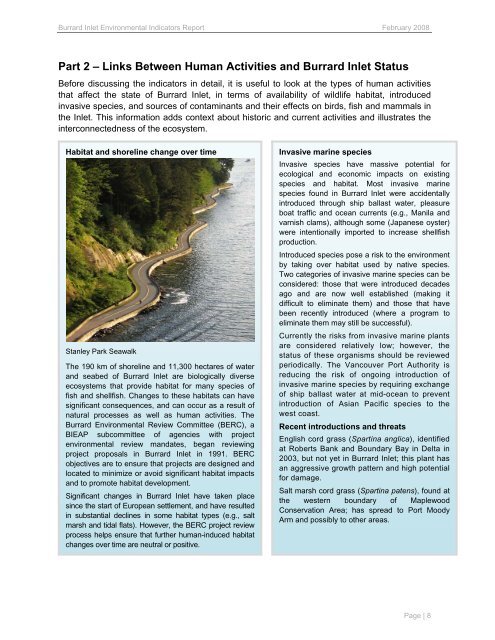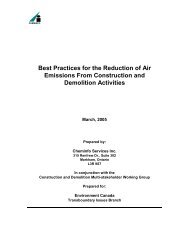Burrard Inlet Environmental Indicators Report - the BIEAP and ...
Burrard Inlet Environmental Indicators Report - the BIEAP and ...
Burrard Inlet Environmental Indicators Report - the BIEAP and ...
You also want an ePaper? Increase the reach of your titles
YUMPU automatically turns print PDFs into web optimized ePapers that Google loves.
<strong>Burrard</strong> <strong>Inlet</strong> <strong>Environmental</strong> <strong>Indicators</strong> <strong>Report</strong> February 2008<br />
Part 2 – Links Between Human Activities <strong>and</strong> <strong>Burrard</strong> <strong>Inlet</strong> Status<br />
Before discussing <strong>the</strong> indicators in detail, it is useful to look at <strong>the</strong> types of human activities<br />
that affect <strong>the</strong> state of <strong>Burrard</strong> <strong>Inlet</strong>, in terms of availability of wildlife habitat, introduced<br />
invasive species, <strong>and</strong> sources of contaminants <strong>and</strong> <strong>the</strong>ir effects on birds, fish <strong>and</strong> mammals in<br />
<strong>the</strong> <strong>Inlet</strong>. This information adds context about historic <strong>and</strong> current activities <strong>and</strong> illustrates <strong>the</strong><br />
interconnectedness of <strong>the</strong> ecosystem.<br />
Habitat <strong>and</strong> shoreline change over time<br />
Stanley Park Seawalk<br />
The 190 km of shoreline <strong>and</strong> 11,300 hectares of water<br />
<strong>and</strong> seabed of <strong>Burrard</strong> <strong>Inlet</strong> are biologically diverse<br />
ecosystems that provide habitat for many species of<br />
fish <strong>and</strong> shellfish. Changes to <strong>the</strong>se habitats can have<br />
significant consequences, <strong>and</strong> can occur as a result of<br />
natural processes as well as human activities. The<br />
<strong>Burrard</strong> <strong>Environmental</strong> Review Committee (BERC), a<br />
<strong>BIEAP</strong> subcommittee of agencies with project<br />
environmental review m<strong>and</strong>ates, began reviewing<br />
project proposals in <strong>Burrard</strong> <strong>Inlet</strong> in 1991. BERC<br />
objectives are to ensure that projects are designed <strong>and</strong><br />
located to minimize or avoid significant habitat impacts<br />
<strong>and</strong> to promote habitat development.<br />
Significant changes in <strong>Burrard</strong> <strong>Inlet</strong> have taken place<br />
since <strong>the</strong> start of European settlement, <strong>and</strong> have resulted<br />
in substantial declines in some habitat types (e.g., salt<br />
marsh <strong>and</strong> tidal flats). However, <strong>the</strong> BERC project review<br />
process helps ensure that fur<strong>the</strong>r human-induced habitat<br />
changes over time are neutral or positive.<br />
Invasive marine species<br />
Invasive species have massive potential for<br />
ecological <strong>and</strong> economic impacts on existing<br />
species <strong>and</strong> habitat. Most invasive marine<br />
species found in <strong>Burrard</strong> <strong>Inlet</strong> were accidentally<br />
introduced through ship ballast water, pleasure<br />
boat traffic <strong>and</strong> ocean currents (e.g., Manila <strong>and</strong><br />
varnish clams), although some (Japanese oyster)<br />
were intentionally imported to increase shellfish<br />
production.<br />
Introduced species pose a risk to <strong>the</strong> environment<br />
by taking over habitat used by native species.<br />
Two categories of invasive marine species can be<br />
considered: those that were introduced decades<br />
ago <strong>and</strong> are now well established (making it<br />
difficult to eliminate <strong>the</strong>m) <strong>and</strong> those that have<br />
been recently introduced (where a program to<br />
eliminate <strong>the</strong>m may still be successful).<br />
Currently <strong>the</strong> risks from invasive marine plants<br />
are considered relatively low; however, <strong>the</strong><br />
status of <strong>the</strong>se organisms should be reviewed<br />
periodically. The Vancouver Port Authority is<br />
reducing <strong>the</strong> risk of ongoing introduction of<br />
invasive marine species by requiring exchange<br />
of ship ballast water at mid-ocean to prevent<br />
introduction of Asian Pacific species to <strong>the</strong><br />
west coast.<br />
Recent introductions <strong>and</strong> threats<br />
English cord grass (Spartina anglica), identified<br />
at Roberts Bank <strong>and</strong> Boundary Bay in Delta in<br />
2003, but not yet in <strong>Burrard</strong> <strong>Inlet</strong>; this plant has<br />
an aggressive growth pattern <strong>and</strong> high potential<br />
for damage.<br />
Salt marsh cord grass (Spartina patens), found at<br />
<strong>the</strong> western boundary of Maplewood<br />
Conservation Area; has spread to Port Moody<br />
Arm <strong>and</strong> possibly to o<strong>the</strong>r areas.<br />
Page | 8
















